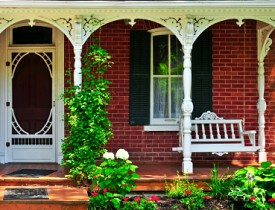Choosing the Right Exterior Wood Trim
 Are you thinking about installing decorative wood trim on the outside of your home? The right exterior wood trim can take your home's curb appeal from so-so to so gorgeous! Because the wood you use for trim will be exposed to the elements, it must be able to withstand exposure to sun, heat, cold, rain, and snow. It also needs to be resistant to fungus and insects. To choose the right wood for your house trim, read our overview of 4 common woods recommended for outside wood trim.
Are you thinking about installing decorative wood trim on the outside of your home? The right exterior wood trim can take your home's curb appeal from so-so to so gorgeous! Because the wood you use for trim will be exposed to the elements, it must be able to withstand exposure to sun, heat, cold, rain, and snow. It also needs to be resistant to fungus and insects. To choose the right wood for your house trim, read our overview of 4 common woods recommended for outside wood trim.
Western Red Cedar
Of all the woods for exterior applications, western red cedar is a top choice. A natural insulator, it also resists decay and insect infestation. Additionally, it can be stained or painted as you wish. Its attractive appearance works well for house trim, including fascia boards, corner boards, and trim around windows and doors.
Western red cedar is available in both clear and knotty grades. The clear grade means that the boards possess fewer of the knots and other blemishes inherent in natural wood products. Less expensive knotty grade boards are used for a more rustic, earthy appearance.
Redwood
California redwood is one of the most popular maintenance-free woods for exterior building purposes. Naturally resistant to insect damage, rotting, splitting, and shrinking, it is ideally suited for deck construction and exterior wood trim.
Because it is naturally strong and durable, California redwood is easy to maintain with just an occasional cleaning. In fact, the California Redwood Association recommends that you not apply finishes, such as varnish, oil, or polyurethane, to redwood.
White Oak
When choosing oak for exterior trim, be sure to buy white oak as opposed to red oak. Red oak should only be used for interior decorative wood trim, since it is porous and therefore easily damaged by water. White oak, on the other hand, is a closed-pore species, which makes it highly resistant to rot and decay. It’s also extremely durable.
White oak trim can be painted or stained (use only exterior grade finishes to protect the wood against UV rays), but it will likely require maintenance every few years.
Southern Yellow Pine
A common trim board is pressure-treated southern yellow pine. It is inexpensive and widely available, but it tends to warp when it absorbs moisture. Unlike cedar and redwood, southern yellow pine is less stable and wood-eating insects consider it delicious food. Therefore, this type of decorative wood trim will need more intensive upkeep and maintenance, in terms of cleaning and regular resealing. It also requires more nails during installation to retain the desired shape.
Avoid any boards with knots, since these can leak tannin, a water-soluble natural component of certain woods. Tannin will “bleed” through and discolor the paint you use on the trim --- unless a quality primer has been applied first.
While the initial investment to install Southern yellow pine trim is less, factor in the time and cost of maintenance. It may work out more expensive in the long run than the cedar or redwood options.
Hire a professional carpenter for expert design and installation of your exterior wood trim.
This article was updated November 9, 2017.
Looking for a Pro? Call us (866) 441-6648

Carpentry Average Costs
Carpenters Experiences

Deck Repair On A Deadline

No Budget For A New Deck This Year? Try This Affordable Option



